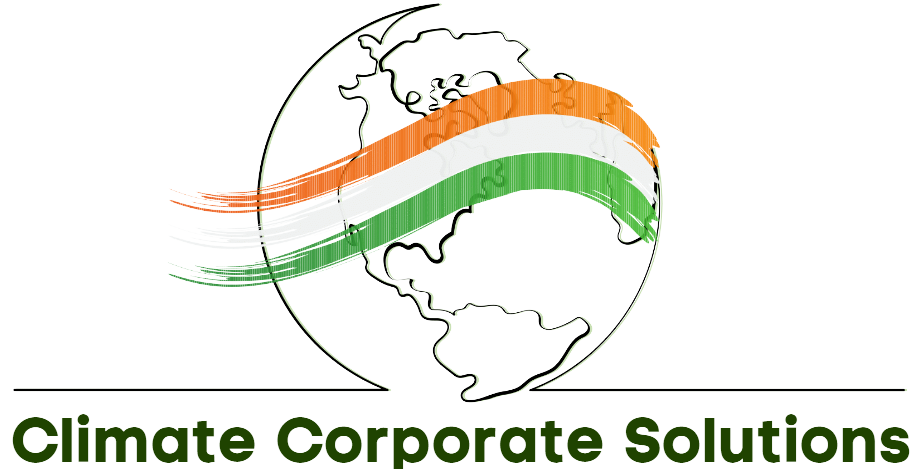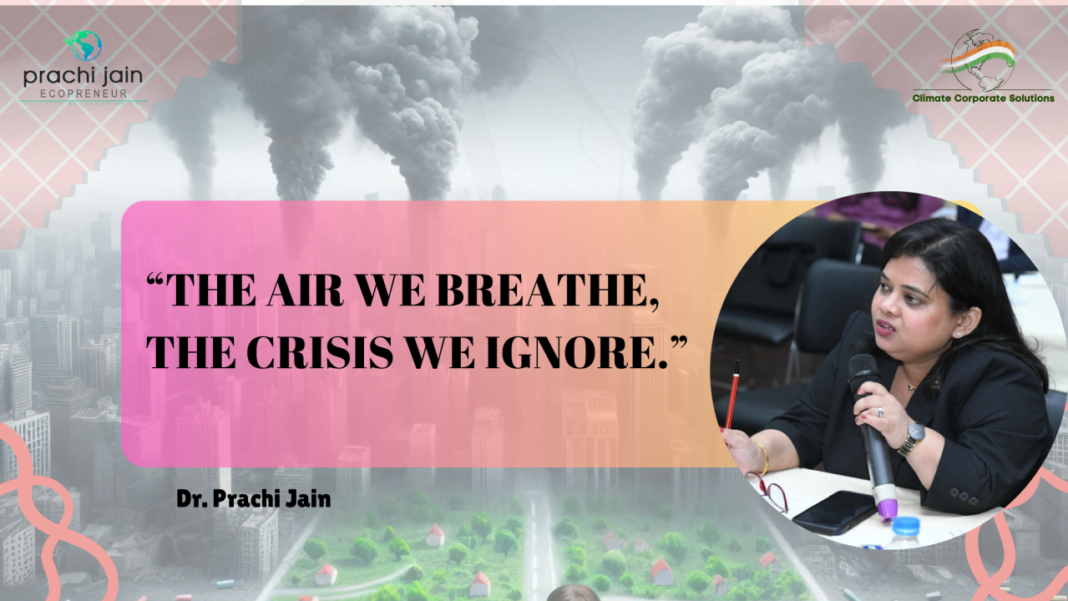Dear Readers!!!
Today, let us chit-chat about the most vital element essential for survival- AIR.
The air we breathe has always been our most essential resource, yet today, it is laced with pollutants that threaten human health and economic stability. As climate change accelerates, the air quality in cities, rural areas, and even once-pristine environments is deteriorating alarmingly. What was once a local issue, driven by industrial emissions and vehicle exhaust, is now a global crisis, amplified by rising temperatures, extreme weather events, and shifting atmospheric patterns.
The link between climate change and air pollution is no longer up for debate; instead, it is a vicious cycle that exacerbates the other. Warmer temperatures trap pollutants closer to the surface, wildfires release massive amounts of particulate matter, and desertification spreads fine dust across continents.
The result? A surge in respiratory illnesses, cognitive decline, and plummeting workplace productivity, all while global healthcare costs soar. In 2023 alone, air pollution was responsible for 7 million premature deaths worldwide, with 99% of the population breathing air that fails to meet World Health Organization (WHO) safety standards.
Nevertheless, the damage does not stop with human health. The global economy is also choking on polluted air. Research indicates that polluted air reduces worker efficiency, increases absenteeism, and impairs cognitive function, resulting in annual economic losses of $8.1 trillion, equivalent to 6.1% of global GDP. With air pollution now being recognised as an environmental, public health, and financial crisis, the urgent question remains: How did we get here, and what can be done before we reach a point of no return?
So, how do the rising temperatures make the air deadlier? Is there any Climate-Pollution Feedback Loop?
At first glance, air pollution and climate change might seem like separate issues. One is caused by smokestacks, exhaust fumes, and industrial emissions, while the other results from carbon buildup in the atmosphere, which traps heat and alters weather patterns. However, digging deeper, it becomes clear that climate change is not just a consequence of air pollution, but also exacerbates it.
As global temperatures rise, chemical reactions in the atmosphere accelerate, resulting in higher concentrations of ground-level ozone —a hazardous pollutant associated with asthma, lung disease, and cardiovascular disorders. Studies show that with every 1°C rise in temperature, ozone levels increase by 3%, leading to more prolonged and severe smog episodes. Cities like Delhi, Beijing, and Los Angeles now regularly experience hazardous air quality levels, forcing schools to close, businesses to slow down, and emergency rooms to fill with respiratory cases.
Beyond just ozone pollution, climate change is exacerbating the most extreme air pollution event: wildfires. The connection is clear: hotter, drier conditions create the perfect environment for wildfires to ignite and spread uncontrollably. In 2023, Canadian wildfires released more carbon into the atmosphere than the country’s total annual emissions, blanketing North America in toxic smoke and even impacting European air quality. The fine particulate matter (PM2.5) from these wildfires penetrates deep into the lungs and bloodstream, increasing the risk of heart attacks, strokes, and premature deaths.
Nevertheless, the problem does not end with fires. Climate change is also intensifying dust storms, carrying pollution across continents. The Sahara Dust Plume, which once reached parts of North America only on rare occasions, is now a frequent phenomenon, bringing fine particulate matter and heavy metals across thousands of miles. In Asia, shifting monsoon patterns trigger mould growth and bacterial pollution in flood-affected regions, increasing respiratory infections. Meanwhile, extreme heat traps pollution in urban air pockets, creating ‘pollution domes’ that suffocate cities for weeks.
The science is precise: climate change is making air pollution more widespread, persistent, and lethal than ever before. But how does this impact human health?
An important question that often hits my mind is, what is the health toll of polluted air? What are the health impacts of breathing the toxic air?
For decades, we have known that poor air quality leads to respiratory illnesses, heart disease, and early mortality. However, in recent years, scientists have uncovered even more profound impacts—from cognitive decline to mental health disorders, from lower birth weights to weakened immune systems. Explaining simply,polluted air affects not just our lungs—it impacts every body organ.
One of the most immediate threats is the surge in respiratory diseases. Cities experiencing frequent air pollution spikes report higher asthma, bronchitis, and chronic obstructive pulmonary disease (COPD) cases. In the United States alone, air pollution triggers over 25 million asthma attacks per year, leading to thousands of emergency room visits and hospitalizations. Studies also show that exposure to fine particulate matter (PM2.5) increases the risk of heart attacks by 20%, as pollutants enter the bloodstream and cause inflammation in blood vessels.
However, one of the most alarming discoveries is how air pollution affects the brain. Harvard researchers have found that short-term exposure to high pollution levels can impair memory, reduce attention span, and weaken problem-solving abilities. Over time, chronic exposure has been linked to higher rates of depression, anxiety, and even neurodegenerative diseases like Alzheimer’s. A 2025 study published in The Guardian found that children raised in polluted environments score lower on IQ tests and have reduced cognitive function compared to those raised in cleaner air.
Even before birth, air pollution is shaping human health. Pregnant women exposed to high pollution levels are more likely to experience preterm births, give birth to babies with low birth weights, and have children with long-term developmental disorders. In regions where pollution is severe, infant mortality rates are significantly higher, with babies suffering from weakened immune systems from the moment they are born.
Another important aspect to understand and analyze is the economic fallout of air pollution. How is polluted air costing trillions to global economies?
While the health impacts are devastating, the economic costs of polluted air are equally staggering. A 2024 report from the World Bank revealed that air pollution-related illnesses cost the global economy $8.1 trillion annually, draining public healthcare systems and reducing workforce productivity.
In fact, pollution-related illnesses now account for the loss of 1.2 billion workdays globally each year, projected to reach 3.8 billion by 2060. Workers in high-pollution cities report higher rates of absenteeism, fatigue, and reduced cognitive efficiency, resulting in billions of dollars in lost productivity. Even indoors, businesses are affected—research shows that poor air quality in office spaces reduces employee performance by up to 10%.
Meanwhile, air pollution is also crippling the agricultural sector. Studies show that ozone pollution reduces crop yields by up to 10%, particularly for staple foods like wheat and rice. In South Asia, pollution-induced agricultural losses are already threatening food security, making the crisis even more urgent.
So, what is the Path Forward, and how can the nations worldwide reclaim Clean Air in the Face of Climate Change?
We all understand that the damage is severe; however, it is not irreversible—if we act swiftly. Mitigation strategies must tackle climate change and air pollution together rather than treat them as separate crises. Some of the vital mitigation strategies are:
✅Accelerating the Clean Energy Transition – Phasing out coal, oil, and gas in favour of renewables can dramatically reduce air pollution and slow climate change.
✅Strengthening Urban Policies – Expanding public transport, pedestrian-friendly infrastructure, and green spaces can reduce emissions in cities.
✅Stricter Global Air Quality Standards – Governments must enforce industrial emissions reductions, invest in real-time air monitoring, and penalize polluters.
✅Massive Reforestation & Urban Greening – Trees act as natural air purifiers, absorbing pollutants while cooling down cities. Expanding tree cover in polluted regions could be a game-changer for air quality.
In conclusion, the link between climate change and air pollution is not just an environmental issue but a public health emergency and an economic crisis. Every day that action is delayed, millions suffer, billions are lost, and the planet inches closer to irreversible damage. The fight for clean air is a fight for human survival.
The question is no longer whether we should act but whether we can afford not to.
Till we meet again…
Dr Prachi Jain



